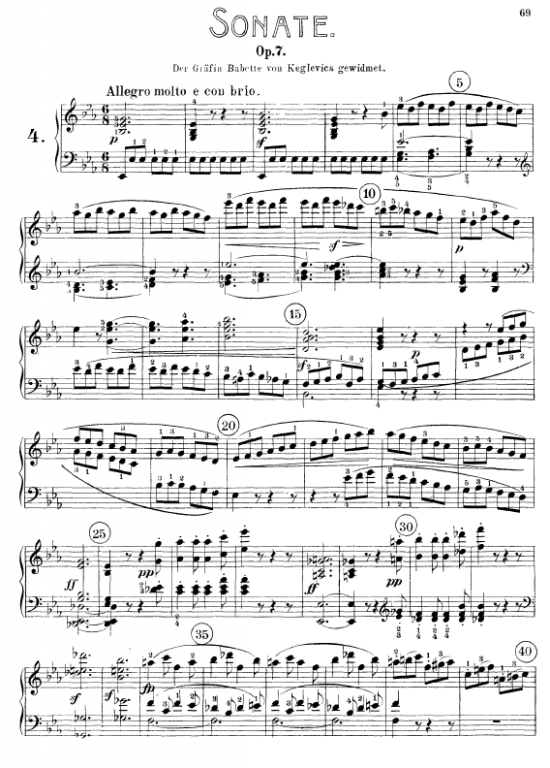Ноты зарубежной классической музыки
- Соната №1
- Соната №2
- Соната №3
- Соната №4
- Соната №5
- Соната №6
- Рондо в турецком стиле
- Лакримоза из «Реквиема»
- Симфония №6
Людвиг ван Бетховен
- К Элизе
- Соната №14 ор. 17 № 2 (Лунная соната)
- Похоронный марш (Funeral March)
Сонаты
- Соната №1 Opus 2 № 1 (F-dur)
- Соната №2 Opus 2№2 (A-dur)
- Соната №3 Opus 2 № 3 (C-dur)
- Соната №4 Opus 7 (Es-dur)
- Соната №5 Opus 10 № 1 (C-moll)
- Соната №6 Opus 10 № 2 (F-dur)
- Соната №7 Opus 10 № 3 (D-dur)
- Соната №8 Opus 13 (C-moll) (Патетическая)
- Соната №9 Opus 14 № 1 (E-dur)
- Соната №10 Opus 14 № 2 (G-dur)
- Соната №11 Opus 22 (B-dur)
- Соната №12 Opus 26 (As-dur) (С Похоронным маршем)
- Соната №13 Opus 27 № 1 (Es-dur) (Sonata quasi una fantasia)
- Соната №14 Opus 27 № 2 (Cis-moll) (Лунная)
- Соната №15 Opus 28 (D-dur) (Пасторальная)
- Соната №16 Opus 31 № 1 (G-dur)
- Соната №17 Opus 31 № 2 (D-moll) (Буря)
- Соната №18 Opus 31 № 3 (Es-dur) (Охота)
- Opus 49: 2 сонаты для фортепиано (1792)
- Соната №19 Opus 49 № 1 (G-moll)
- Соната №20 Opus 49 № 2 (G-dur)
- Соната №21 Opus 53 (C-dur) (Вальдштейн)
- Соната №22 Opus 54 (F-dur)
- Соната №23 Opus 57 (F-moll) (Appassionata)
- Соната №24 Opus 78 (Fis-dur) (A Thérèse)
- Соната №25 Opus 79 (G-dur)
- Соната №26 Opus 81a (Es-dur) (Прощальная)
- Соната №27 Opus 90 (E-moll)
- Соната №28 Opus 101 (A-dur)
- Соната №29 Opus 106 (B-dur) (Хаммерклавир)
- Соната №30 Opus 109 (E-dur)
- Соната №31 Opus 110 (As-dur)
- Соната №32 Opus 111 (C-moll)
Клод Дебюсси
- Этюд №1 (Дебюсси)
- Этюд №2 (Дебюсси)
- Этюд №3 (Дебюсси)
- Этюд №4 (Дебюсси)
- Этюд №5 (Дебюсси)
- Этюд №6 (Дебюсси)
- Этюд №7 (Дебюсси)
- Этюд №8 (Дебюсси)
- Этюд №9 (Дебюсси)
- Этюд №10 (Дебюсси)
- Этюд №11 (Дебюсси)
- Этюд №12 (Дебюсси)
Иоган Себестьян Бах
- Прелюдия до-мажор «Аве Мария» из ХТК
- Прелюдия и фуга №1 ХТК 1 (Бах)
- Прелюдия и фуга №2 ХТК 1 (Бах)
- Прелюдия и фуга №3 ХТК 1 (Бах)
- Прелюдия и фуга №4 ХТК 1 (Бах)
- Прелюдия и фуга №5 ХТК 1 (Бах)
- Прелюдия и фуга №6 ХТК 1 (Бах)
- Прелюдия и фуга №7 ХТК 1 (Бах)
Фредерик Шопен
- Ноктюрн op.9 №2
- Ноктюрн cis-moll
- Ноктюрн c-moll ор. 48 №1
- Колыбельная
- Прелюдия op. 28 №4
- Вальс op. 64 №2
- Вальс a-moll op.34 №2
- Похоронный марш c-moll ор. 72 №3
- Похоронный марш из Сонаты b moll
Франц Шуберт
- Экспромт №1 op. 90 (Шуберт)
- Экспромт №2 op. 90 (Шуберт)
- Экспромт №3 op. 90 (Шуберт)
- Экспромт №4 op. 90 (Шуберт)
Прочие
- Танго «Кумпарсита»
- Свадебный марш (Ф. Мендельсон)
- Волнения (Эрик Сати)
Fourth Movement (Presto Con Fuoco)
Form: Sonata Form. Eb Major.
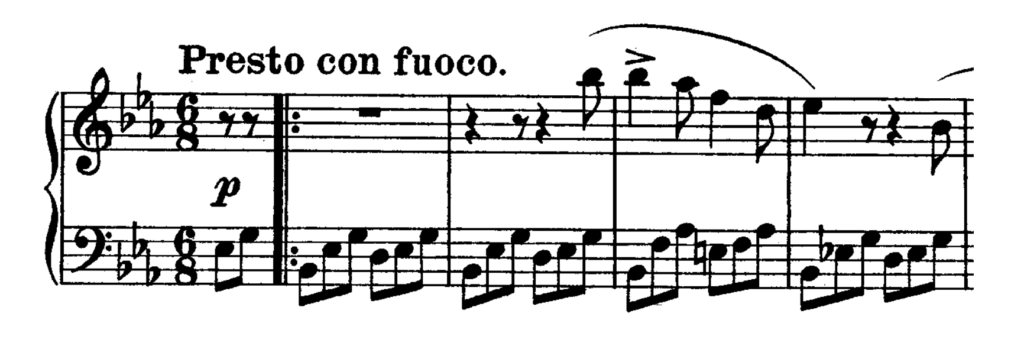
EXPOSITION:
Bars 1-29: First Subject in E flat major (tonic). The first sentence of the first subject ending with full close in the tonic, Bar 7, is repeated, Bars 7-13. The first subject may be divided into two parts totally different in character: the first part, Bars 1-7 (which is repeated, Bars 7-13), and the second part, Bars 13-29, both beginning and ending in tonic key.
Bars 29-65: Connecting Episode. The connecting episode commences with the passage, Bars 21-25, transposed into tonic minor key, succeeded by some new material in the key of the dominant, in which key it ends, Bar 65.
Bars 65-77: Second Subject in B flat major. The second subject is constructed almost entirely upon the common chord of B flat. The rhythm of it is borrowed from the second part of the first subject.
Bars 77-80: Bars 77-80 form a passage, consisting of an extension of the chord of the dominant seventh, leading to the repetition of the exposition, and after that to the development.

Double bar and repeat.
DEVELOPMENT:
Bars 83-174: The development commences with the passage (slightly altered) which precedes it, transposed into the key of G flat. The second part of the first subject the appears in that key; at Bar 99 a new figure is introduced in B minor (enharmonic modulation, Bars 94-95, G flat to F sharp), repeated, Bars 107-110, in C minor; at Bars 111-114 in A flat major; at Bars 115-118 in D flat major; the tonic chord of which is treated as a Neapolitan sixth of the key of C, and the figure finally appears in that key, Bars 119-122, The second part of the first subject is then again reverted to in the key of C. After some further modulation the development ends upon dominant harmony.
RECAPITULATION:
Bars 174-202: First Subject in original key. The first subject re-appears in its original form.
Bars 202-242: Connecting episode. The connecting episode commences as before, and is composed of nearly the same matter, transposed for the most part into G flat major.
Bars 242-266: Second Subject in G flat major. The second subject re-appears in the key of G flat major, Bar 242, and in the tonic minor key, Bar 254, modulating, Bar 265, to the key of the dominant.
Bars 266-End: Coda. The Coda commences with a prolonged variation upon the chord of the dominant seventh. From Bars 284 to the end there are repeated references to the first subject.
Первое знакомство с Патетической сонатой
Фортепианная соната «Опус 13», более известная, как «Патетическая», безусловно, является одной из самых известных работ Людвига ван Бетховена.
Первую часть произведения узнает, наверное, любой человек, не занимающийся музыкой, а мелодия второй части и вовсе используется в произведениях современной поп-культуры.
Произведение часто используют в кинокартинах, в различных телевизионных передачах, его часто используют музыканты в своих так называемых «кавэр версиях» (интерпретируют сонату по-своему на самых разных музыкальных инструментах, в самых разных обработках и стилях) и так далее.
Из всех бетховенских фортепианных сонат, наверное, только «Лунная» сможет посоревноваться с «Патетической» в плане популярности среди людей, не являющихся фанатами классической музыки.
Слушать произведение
В общем, пора уже непосредственно знакомиться с произведением. Для этого предлагаем послушать данное произведение в исполнении замечательного пианиста, Валерия Вишневского:
Слушать часть 1:
Теперь, когда Вы послушали эту замечательную сонату, предлагаем рассмотреть самую основную информацию, которую неплохо было бы знать о данном произведении.
Сразу отметим, что проводить подробный музыкальный анализ данного произведения мы не будем, ибо его уже сотни раз проводили и гораздо более опытные музыковеды: Юрий Кремлев, Александр Гольденвейзер, Эдвин Фишер и другие.
Учитывая, что их материалы легко можно найти в сети, мы не будем изобретать колесо, ибо вряд ли сможем проанализировать данную сонату лучше, чем выше названные профессионалы.
Более того, нас читают в большинстве случаев не профессиональные музыканты, а самые разные люди, не особо знакомые с музыкальной терминологией, которые просто хотят познакомиться с творчеством Бетховена. Именно для последних было бы полезным ознакомиться со следующей информацией.
Third Movement (Menuetto – Moderato E Grazioso)
Form: Ternary Form. Eb Major.
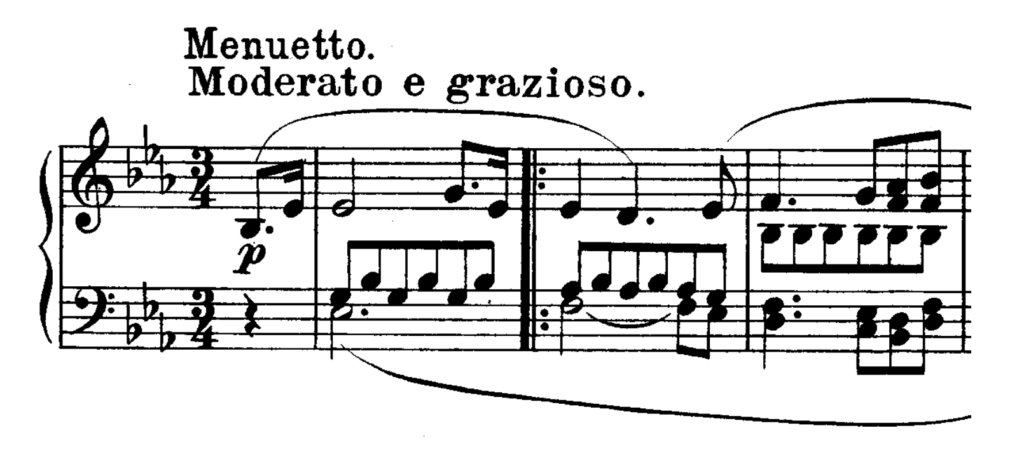
The Menuetto and Trio are in the same key, which is unusual. (See also Allegretto and Trio, Op. 27 No. 2).
FIRST PART – MENUETTO:
Bars 1-9: First Subject in E flat major (tonic). The first subject ends on half close upon the dominant.
Bars 12-20: Second Subject in E flat major (tonic). The second subject is developed from the first subject and is in the same key.
Double bar and repeat from Bar 13.
SECOND PART – TRIO:
The Second Part is in Simple Binary form.

Bars 1-9: First Subject in E flat major, ending in B flat major.
Double bar and repeat.
Bars 10-16: Development.
Bars 16-24: First Subject in original key, altered so as to end in E flat major.
Double bar and repeat from Bar 10.
THIRD PART:
Repetition of “Menuetto” (Part I).
Bars 45-End: In the Coda there is another instance (see Sonata No. 17, second movement) of the subdominant harmony playing an important part in the Coda, making a prolonged plagal cadence.
Navigation etc.
| Beethoven Piano Sonatas | |
|
|
Когда была написана?
Нам точно известная дата, когда издатель Франц Антон Хоффмайстер опубликовал «Патетическую сонату» — это было 18 декабря 1799 года.
Считается, что незадолго до этого, произведение было впервые опубликовано другим издателем — Йозефом Эдером. Однако, по другим данным, Хоффмайстер опубликовал произведение раньше Эдера. Точную дату опубликования произведения Эдером мы не знаем и, следовательно, гадать на кофейной гуще не будем.
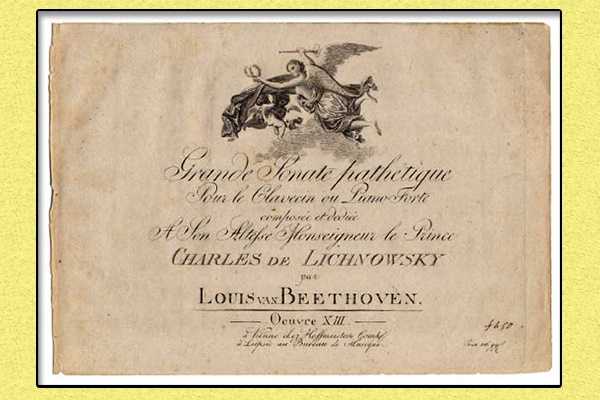
Но это актуально, если мы говорим об издании произведения. Ну а, если мы говорим о, собственно, временных рамках работы над его сочинением самим композитором, то традиционно считается, что Бетховен написал Патетическую сонату за год до ее опубликования — то есть, в 1798 году.
Стоит отметить, что некоторые, найденные исследователями эскизы говорят нам о том, что первые наброски фрагментов Патетической сонаты велись чуть ли ни с 1796 года.
Известный бетховеновед Барри Купер, в свою очередь, продлил гипотетическую дату окончания композитором работы над этим произведением аж до октября 1799 года. Возможно, именно тогда Бетховен внес в сонату самые последние штрихи.
General Information
| Work Title | Piano Sonata No.18 |
|---|---|
| Alternative. Title | The Hunt |
| Name Translations | Piano Sonata No. 18; Klaviersonate Nr. 18; Sonata para piano n.º 18; Sonate pour piano nº 18 de Beethoven; Sonata per pianoforte n. 18; ピアノソナタ第18番; Pianosonate nr. 18; Sonata fortepianowa nr 18 Beethovena; Соната для фортепиано № 18; Соната для фортепіано № 18; Sonata per a piano núm. 18; Σονάτα για πιάνο No. 18; 피아노 소나타 18번; 第18號鋼琴奏鳴曲 (貝多芬) |
| Name Aliases | La caccia (apocrifo); Piano Sonata No. 18 in E-flat Major, Op. 31, No. 3; Pianosonate nr. 18 (Beethoven) |
| Authorities | |
| Composer | Beethoven, Ludwig van |
| Opus/Catalogue NumberOp./Cat. No. | Op.31 No.3 |
| I-Catalogue NumberI-Cat. No. | ILB 179 |
| Key | E-flat major |
| Movements/SectionsMov’ts/Sec’s | 4 movements:
|
| Year/Date of CompositionY/D of Comp. | 1801-02 |
| First Publication. | 1802 |
| Average DurationAvg. Duration | 22-23 minutes |
| Composer Time PeriodComp. Period | Classical |
| Piece Style | Classical |
| Instrumentation | piano |
| Discography | |
| External Links | Wikipedia article |
Second Movement (Scherzo – Allegro Vivace)
Form: Sonata Form. Ab Major.
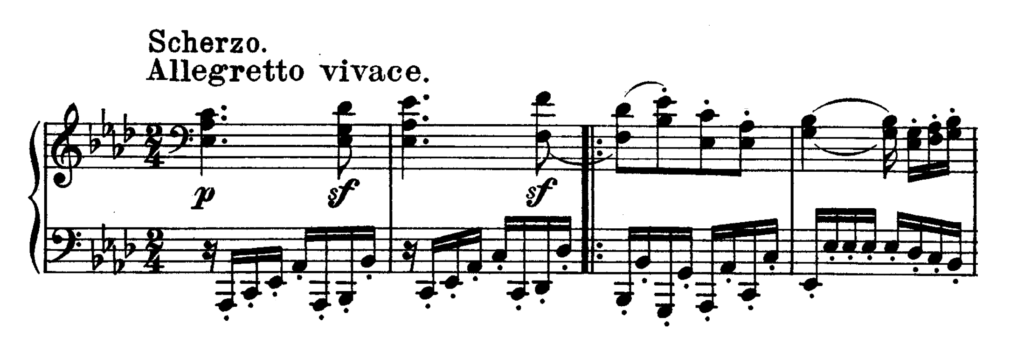
The Scherzo, which Beethoven sometimes used instead of the Menuetto, does not here take that position, as it is followed by a Menuetto and Trio. This is the only instance in which Beethoven has used 2/4 time for Scherzo.
EXPOSITION:
Bars 1-9: First Subject in A flat major (tonic). The first subject consists of a sentence of eight bars ending with full close in the tonic, extended to nine bars by the repetition of the final cadence.

Bars 9-15: Connecting Episode. The connecting episode simply consists of a passage modulating to F minor, upon the dominant of which it ends, Bar 15.
Bars 15-34: The entrance of the second subject is delayed, there is a passage of four bars, Bars 15-19, beginning in D flat and proceeding down to B flat, G natural, and E flat, forming the chord of the dominant seventh, after which the first subject and the connecting episode are repeated, Bars 20-34.
Bars 34-50: Second Subject, beginning in F major. The second subject commences in F major, instead of the key of the dominant E flat; it will be seen, however, that it ends in that key, Bar 50.
Bars 50-56: Coda. The Coda might at first glance be looked upon as the second subject, considering that it begins and ends in the key of the dominant, and that the second subject is of indefinite tonality. It is, however, clearly a Coda formed of tonic and dominant harmony. It should be noted that Beethoven’s Scherzos are often somewhat irregular as to form.
Bars 56-61: Bars 56-61 form a passage leading to the repetition of the enunciation, after which, with Bars 64-65, it leads to the development.
Double bar and repeat.
DEVELOPMENT:
Bars 66-108: The development commences with a part of the first subject in the key of F major. After a reference to second subject a portion of the first subject appears in the key of C major, Bar 85. A new figure is introduced, Bars 92-97. After some scale passages it ends in the tonic key, Bar 108.
RECAPITULATION:
Bars 108-116: First Subject in original key. The first subject and connecting episode re-appear in the original keys.
Bars 116-122: Connecting Episode. The first subject and connecting episode re-appear in the original keys.
Bars 122-141: The first subject and connecting episode are repeated as before, excepting that the first subject is varied.
Bars 141-157: Second Subject, beginning in G flat major. The second subject re-appears, beginning in the key of G flat, which is very irregular, ending, however, in the tonic key, Bar 157.
Bars 157-End: Coda. The Coda is elongated.
First Movement (Allegro)
Form: Sonata Form. Eb Major.

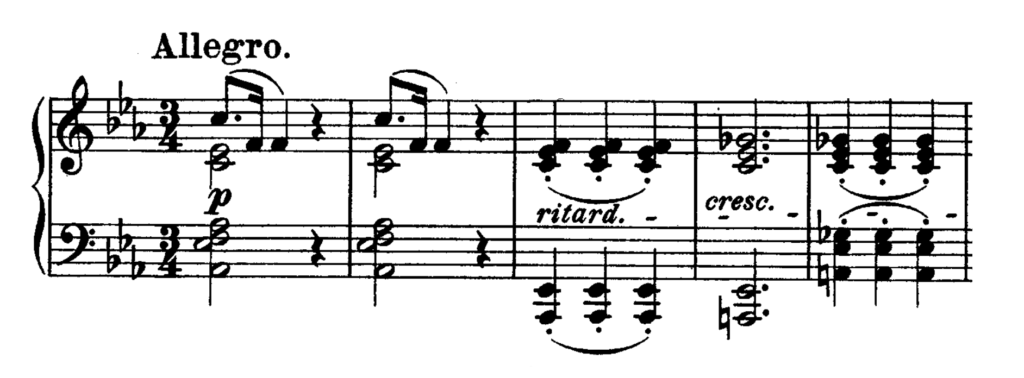
EXPOSITION:
Bars 1-29: First Subject in E flat major (tonic). The first subject begins upon the third inversion of the chord of the eleventh. Bars 1-8 are repeated in a different register at Bars 10-17. Bars 18-21 are also repeated (varied), Bars 22-25. The first subject ends with a short passage of the nature of a Codetta, Bars 25-29.
Bars 29-45: Connecting Episode. The connecting episode commences without any break, and flows right from the first subject, which subject is referred to, Bar 33, the third inversion of the chord of the eleventh here having a minor ninth instead of a major as before. The connecting episode ends upon F, the dominant of the second subject key.
Bars 45-64: Second Subject in B flat major. The second subject consists of eight bars, Bars 45-53, which, after a connecting passage of four bars are repeated (varied), Bars 57-64.
Bars 64-86: Coda. The Coda is constructed of new material, and begins and ends in the dominant key; Bars 72-76 are simple arpeggios of the triad of B flat, followed, Bars 78-81, by arpeggios of the dominant chord of B flat accompanied by a shake upon the fifth of a chord. Bar 82 is evidently taken from Bar 9, and Bar 85 from Bar 7.
Bars 86-88: Bars 86-88 form a connecting passage formed from the last phrase of the Coda (Bars 82-84).
Double bar and repeat.
DEVELOPMENT:
Bars 89-137: The development begins like the first subject upon which it is chiefly founded, it ends with the harmony of F minor.
RECAPITULATION:
Bars 137-165: First Subject in original key. The first subject re-appears with the harmony of F minor in the first two bars, Bars 137-138, instead of the third inversion of the eleventh (root B flat), as before
Bars 165-169: Connecting Episode. The connecting episode re-appears without the reference to the first subject, it ends, however, on the dominant (B flat) instead of on F.
Bars 169-190: Second Subject in E flat major (tonic). The connecting passage (Bars 53-56) is varied and extended, Bars 177-183.
Bars 190-End: Coda. The Coda, which begins like that in the exposition, transposed into the tonic key, is extended, the additional bars being founded upon the first subject.



























